I’ve spent a lot of time over the last few years studying heroes, and what our cultural heroes say about society. Much is made of gritty vs. fun, Man of Steel vs. Guardians of the Galaxy. But one thing that is often overlooked is the importance of parody superheroes to this discussion. I think that that parodies serve just as much as a dismantling of the superhero archetype as anything Frank Miller wrote. Not to belabor this too much, but clearly the people behind these parodies were commenting on the pervasive hero-worship of characters like Supes and Cap, and often jabbing the broodiness of Batman and Punisher. There is also a very real message in many of these books: normal people can be heroes, too.
So here’s a by-no-means exhaustive list of some superhero parodies—be sure to join the discussion in the comments!
The first two parodies I found are, appropriately enough, riffs on Superman, but what’s interesting is that neither of them particularly attacks the Man of Steel. Both were made during World War II, and they clearly hold Superman up as an absolute ideal of American bravery, and, best of all, attempt to extend his strength and moral certitude to ordinary people. Or, in the first case, an ordinary mouse.
Super Mouse (1942)
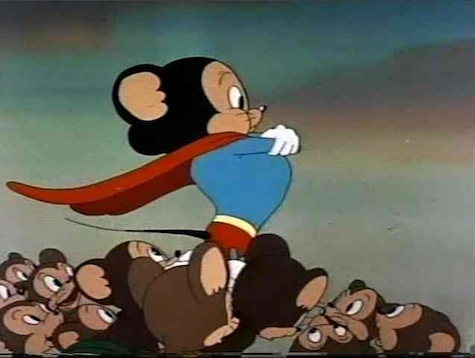
Super Mouse was a cartoon by Paul Terry that eventually morphed into Mighty Mouse, and the main gag was simply that a mouse could do the same things as Superman. He appeared in 1942 and dressed in a familiar blue costume with red trunks and a cape, but Superman wasn’t the only target of this parody; the early cartoons also spoofed both Mario Lanza’s opera work, with the characters singing many of their lines, and old silent serials, by starting action in media res and ending on cliffhangers. Super Mouse/Mighty Mouse had powers including flight, x-ray vision, and even telekinesis, and he fought a wide variety of foes including thinly-veiled Nazis, a super-strong cat, and even a feline Satan, but his usual nemesis was the normal but nefarious kitty named Oil Can Harry.
Snafuperman (1944)
Less subversive than some of the other parodies, this Superman spoof is a one-off from the series of Warner Bros. cartoons featuring Private Snafu, a WWII soldier—with a voice made more famous by a certain sarcastic rabbit—who sucks at soldiering because he refuses to read his manuals. In the cartoon, he is granted the powers of Superman (who is treated as a real person in the world of the film, so why isn’t he stopping the Nazis?) but even with great power, Snafu doesn’t bother with the great responsibility of learning military tactics.
Not Brand ECHH (1967)
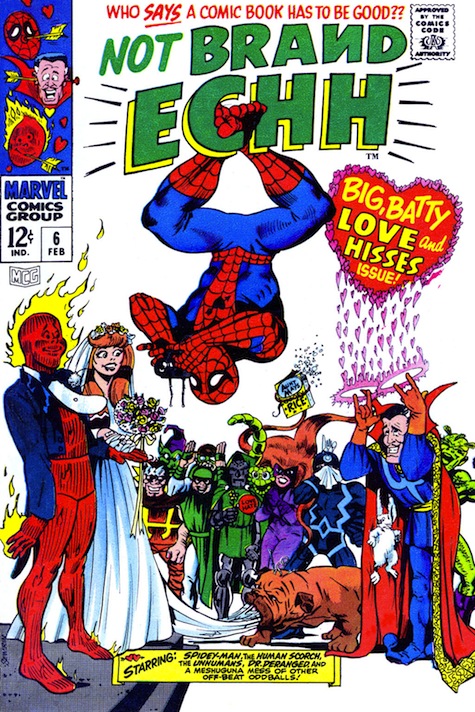
MAD’s usual take was to latch onto whatever pop culture ephemera was big that week, twist the names of the main characters, and then set them up in ridiculous fourth-wall-breaking situations. Not Brand Ecchh was Marvel’s in-house parody line, which seemed designed to undercut an outsider’s ability to mock them. They caricature their own guys plus some DC characters for good measure, skewing the names in the snerking manner of 6th graders. For instance, here Spidey-Man is save from GnatMan’s prank by obliviously diving after a Merry Marvel Marching Society pin at exactly the right second. Not Brand Echhh! was created by the Marvel bullpen, and it shows in the humor.
Spider-Ham (1983)
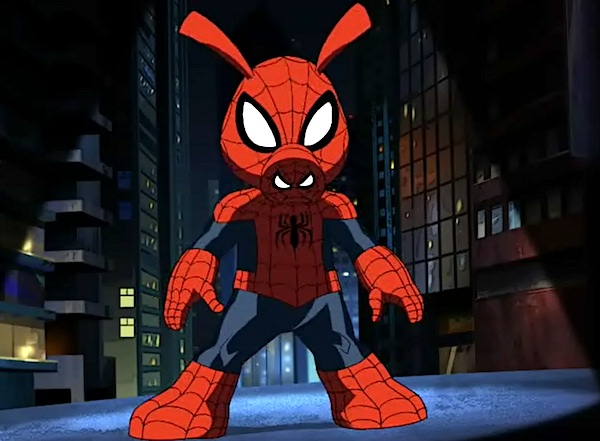
This is a gentle parody aimed at kids that will probably make most adults groan and cover their ears. Spider-Ham, the heroic alter ego of average pig Peter Porker, was created by one writer Tom DeFalco, who has returned to the project over the last thirty years. It isn’t quite the satirical grab-bag that Not Brand-Echh is, but instead focuses on direct Spider-Man parody with a cast of funny animals including J. Jonah Jackal (editor in chief of The Daily Beagle), Ducktor Doom, Nagneto the Magnetic Horse, and, my favorite, Goose Rider.
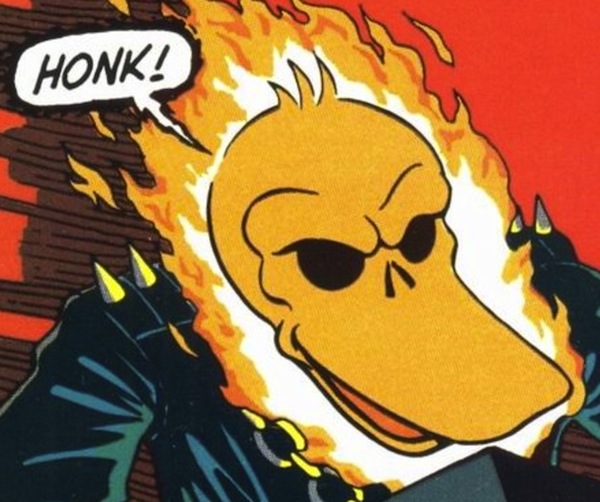
Flaming Carrot (1979)
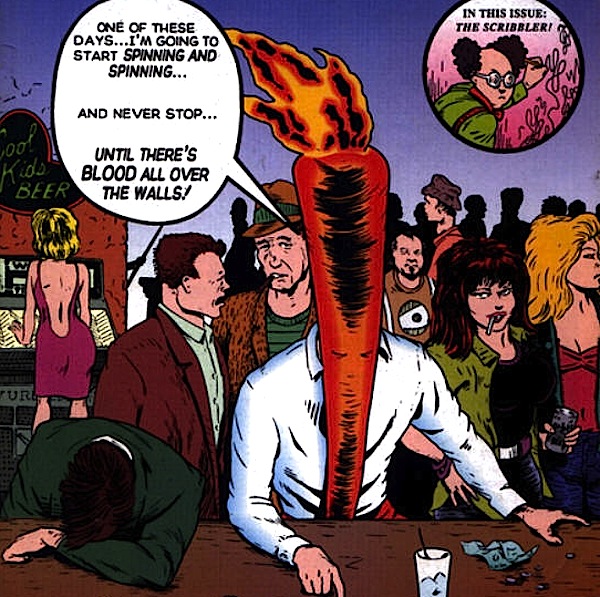
Created by Bob Burden as a parody of The Fin, Flaming Carrot decided he was a superhero after reading 5,000 comics in one sitting. He has no powers, except a willingness to take ridiculous risks and get hurt a lot. He also has a truly eerie carrot mask which is almost as tall as he is. The top of the carrot is also on fire. Burden published the book himself occasionally during the 80s, then moved the title over to Dave Sim’s Aardvark Vanaheim publishing outfit, and it’s since been rereleased digitally. His catchphrase, “Ut!” was stolen from George Harrison: when kids swarmed the stage during the Beatles’ Shea Stadium performance in 1965, he apparently yelled “Ut!” in surprise, and Bob Burden thought it was weird enough to work in the world he was creating. Carrot’s only real superhero accessory is a specially designed pogo stick, created by professional Genius and Mad Scientist Dr. Heller, who also appears in…
Mystery Men! (1999)
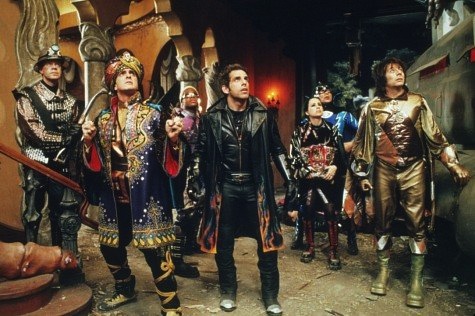
I have a soft spot for Mystery Men. The film certainly isn’t great—it’s too dark and frenetic and skips over world-building to get straight into action scenes. The little bit of context that exists is potentially interesting—superheroes have publicists and corporate sponsorships—but the film doesn’t spend any time mining it. The thing that works, I think, is that each character’s power is rooted in a real emotion or hope, and it gives the whole thing more weight than it should have. The Shoveler is a blue collar hero, and his power, shoveling very well, takes a talent that most people would ignore, and recognizes its dignity; the Bowler was willing to put grad school on hold to help her father get his vengeance from beyond the grave, but she has her own goals in life; and Blue Raja’s mother is excited to learn that her son is a superhero, so much so that she gifts him an old family heirloom to use as weaponry. And Tom Waits can do anything in a film and I’ll watch it. Plus it made me really happy that Captain Amazing is just a dick, and (spoiler alert!) that they inadvertently kill him during their rescue attempt.
Normal Man (1983)
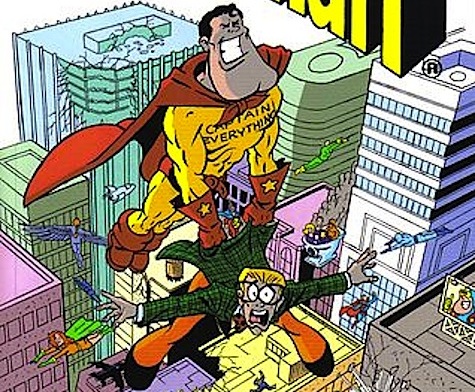
Also coming out of Dave Sim’s Aardvark/Vanaheim Press was Normal Man—a direct subversion of Superman. Norm’s dad, an accountant, believes that his planet is about to blow up, and launches his son into space to save him. (He later realizes he was incorrect in his calculation.) Twenty years later, Norm lands on Levram, where he is the only non-superpowered person—worse still, most of the supers are out to get Norm because he represents a threat to their way of life. This one has a basic inversion of Superman, with digs at Nick Fury, the Fantastic Four and the Justice League throughout. And the lead hero, Captain Everything (what’s with the Captains?), explicitly has the ability to suddenly gain new powers as the plot demands them.
Crimson Bolt/Boltie/Holy Avenger (2010)

James Gunn gave as a particularly dark superhero satire in 2010’s Super. Frank D’Arbo is a fry cook who believes his life is given meaning by his marriage to his wife, Sarah. When she leaves him and returns to a life of drug abuse, he begs God for some sort of sign. What he gets is an encounter with The Holy Avenger, a Christian TV superhero, and some divine tentacles. (This may be a hallucination.) He becomes The Crimson Bolt, a hero in a red patchwork suit, a red hood, and a chestplate with said hood ironed onto it, who compensates for his lack of powers by whacking bad guys with a wrench. He soon acquires a sidekick in Boltie, a bored comic shop employee who enjoys kicking ass a little too much. What begins as a gruesomely funny vigilante parody soon becomes a meditation on superhero culture, the lines between violence and heroism, and the innate eroticism of the super suit. While the Crimson Bolt and Boltie are pastiches, The Holy Avenger is a more direct parody of Bibleman, a Christian superhero who was already a parody of Batman. So many layers! While the original Bibleman is played by Willie Aames of Charles in Charge infamy, Holy Avenger is played by the mighty Nathan Fillion, who also took to superheroing as…
Capain Hammer (2008)
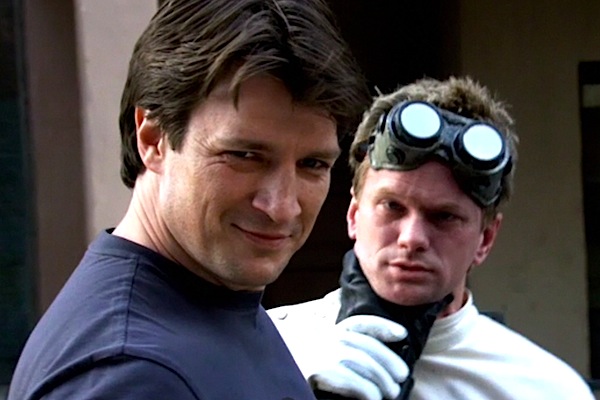
Before The Avengers and his attempt at Wonder Woman, Captain Hammer was Joss Whedon’s first crack at a true comics-style superhero. Naturally, being a Whedon creation, he’s… a little flawed. Granted, Dr. Horrible’s Sing-Along Blog is told from the villain’s perspective, but still: rather than actually being the courageous and generous hero everyone assumes, he’s actually a petty bully. He doesn’t love Penny, but brags about sleeping with her. He’s gratuitously cruel to Dr. Horrible, and his actions end up pushing the poor Doctor to the true villainy he’d only flirted with before. Possibly worst of all, while Horrible truly grieves for Penny, Captain Hammer makes her death all about him, running to a therapist to complain about his loss of power. He is a cardboard cut-out of a hero, which is why we’re not ending this post with him. Instead, I’ll leave you with the greatest hero of them all:
THE TICK! (1986)
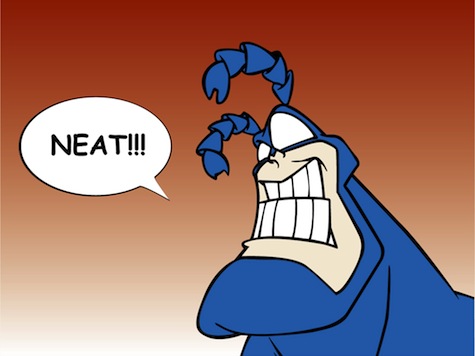
The genius of Ben Edlund’s Tick is that he’s so adaptable. In Edlund’s original comic he’s actually a fairly dark character, an escapee from a mental institution who has to stay tucked snugly into his delusions so that reality won’t get the upper hand. He inadvertently torments another superhero, Clark Oppenheimer, the Clark Kent/Superman parody. Clark seems to be truly well intentioned, but the Tick quickly drives him to homicidal ideation. The story then shifts to the Tick assisting an Elektra parody named Oedipus before the Tick meets his own sidekick, the former accountant Arthur. The comic, like many of the indie comics of the time, feels aggressive. It sounds ridiculous to say that about The Tick, but there it is. I feel like The Tick only becomes The Tick in its last issue, where the Tick is goofy, dumb, and extremely resilient, while Arthur is sensible and tries to make people adhere to a strategy.
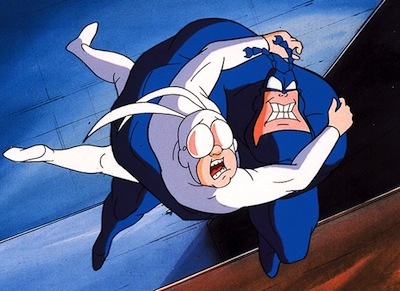 The mid-90s animated series takes the parody and runs with it, with a few direct satires, like Die Fliedermaus and American Maid, as well as more whimsical characters like Sewer Urchin and (my favorite) Man-Eating Cow. The iteration danced between child-friendly silliness and double entendre for the older people in the audience. Plus it introduced the two greatest of all the ridiculous catchphrases: “Spooon!” and “Not in the face!” As far as I’m concerned it’s perfect.
The mid-90s animated series takes the parody and runs with it, with a few direct satires, like Die Fliedermaus and American Maid, as well as more whimsical characters like Sewer Urchin and (my favorite) Man-Eating Cow. The iteration danced between child-friendly silliness and double entendre for the older people in the audience. Plus it introduced the two greatest of all the ridiculous catchphrases: “Spooon!” and “Not in the face!” As far as I’m concerned it’s perfect.
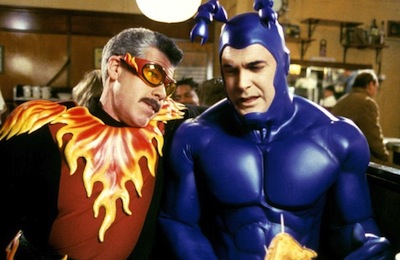 The 2001 live action version is a bit darker, and much more adult, with the Tick as the lone doofy classical superhero parody, surrounded by normal people who have taken up superheroing to add some excitement to their lives, or to work out some of their emotional shit. It is as much Arthur’s story as the Tick’s, and follows his arc as he leaves his accounting firm, fights with his family over his new career, and attempts to be more confident in romance. The other two main characters, Batmanuel and Captain Liberty, are vain, shallow, and obsessed with their images.
The 2001 live action version is a bit darker, and much more adult, with the Tick as the lone doofy classical superhero parody, surrounded by normal people who have taken up superheroing to add some excitement to their lives, or to work out some of their emotional shit. It is as much Arthur’s story as the Tick’s, and follows his arc as he leaves his accounting firm, fights with his family over his new career, and attempts to be more confident in romance. The other two main characters, Batmanuel and Captain Liberty, are vain, shallow, and obsessed with their images.
So, those are my picks! Let me know if I forgot any of your favorites!
Leah Schnelbach thinks we need a Tick movie next. Who’s with her? Come yell “Spoon!” at her on Twitter, if you want.










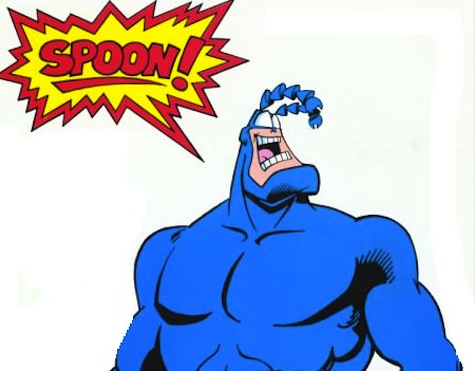
James Gunn also wrote the low budget film THE SPECIALS (2000), which starred Rob Lowe. When it came out, I thought it was hilarious, but it hasn’t held up on recent re-watch. Still, I always hoped it would get a little more attention.
Dave Sim’s Cerberus parodied a number of superhero comics, most notably through the character of The Roach, who at various points becomes Moon Roach, Wolverroach, Captain Cockroach, Secret Sacred Wars Roach, and then begins to parody Neil Gaiman’s Sandman. There’a also a parody of Man-Thing in there, as I recall.
There were tons of superhero parodies in the 60s. Some people might even include the Adam West Batman among them. Right off the top of my head, I would include both Underdog (forget the awful movie from a couple of years ago) and Super Chicken (Fred, you knew this job was dangerous when you took it) on the animation side. In print cartoons, the only thing that occurs to me is Super Goof, which had a pretty long run.
Also from the 60s, are a couple of very short-lived live action TV shows. Mr. Terrific starred Stephen Stimpell (who was mostly known as a stage actor) as a nebbishy gas station attendant who got super powers for 1 hour by taking a pill that only worked on him. It was a supremely silly show, with Dick Gautier as the unknowing civilian friend and the matchless pipes of John McGiver. A year later, there was Captain Nice, which was created by Buck Henry. Similar premise, but I haven’t seen any of those.
The premise of Monty Python’s Bicycle Repair Man is great. In a world of supermen he alone has the power to fix bicycles.
I miss Obvious Man, from the comic Non Sequitur: The superhero who can’t stand the overly obvious or hypocritical. His symbol is the word “Duh” with a slash through it. (Well, duh, of course he has that.)
Anybody remember the cartoons that featured Stretch Man, Tornado Man, and Diaper Man, and other characters? These ‘toons aired in the late ’60s or early ’70s.
The anime Tiger & Bunny works as a parody of superheroes, celebrity-culture, and reality TV (it plays superheroes as basically celebrity athletes).
Superheroing doesn’t pay the bills, so Superheroes have sponsors and compete for points on HeroTV. They also do public appearances, merchandising, and have focus-group-written catchphrases.
It’s basically a superhero buddy-cop story, with an old-fashioned idealistic hero (Wild Tiger) partnered with a modern angst-ridden Dark Avenger-type pretty-boy (Barnaby Brooks Jr.).
Interesting that the Private Snafu cartoon (from Warner Bros.) makes use of Sammy Timberg’s theme from the Fleischer Superman shorts (which was adopted by the radio series as well in 1946). Of course, these films weren’t made for commercial release, and the various animation studios were more collaborative on them than they would’ve been normally.
The live-action The Tick really disappointed me. Only a few of its episodes — mostly the ones written by Ben Edlund — really made use of the comic potential of superheroes themselves. Most of the episodes were just rehashed Seinfeld plots acted out by people who happened to be wearing superhero costumes.
Although I think Mystery Men is actually pretty good. It has its awkward aspects, and was maybe ahead of its time, but I think it holds together pretty well.
@3: The thing about the ’66 Batman is that it’s hardly a parody at all; it’s actually a startlingly faithful adaptation of the Batman comics of the previous decade or so (indeed, the first several storylines are adapted from actual comic-book stories). It’s approaching that material with a wink to the audience, but it doesn’t really exaggerate or alter it, just translates the comic so literally to live action that the inherent absurdity speaks for itself. If anything, the show was considerably less absurd than the comics of the era, since Adam West’s Batman didn’t travel through time, get pestered by Bat-Mite, don bizarre costume variants on a regular basis, get turned into a baby or a gorilla, or get into elaborate prank wars with Superman.
For the love of all that’s goofy, where’s the praise for The Greatest American Hero?
*ahem*. Too Much Coffee Man.
20 years ago, when the Wayans Brothers were everywhere, there was a movie called Blankman starring Damon Wayans which was not-unwatchably stupid.
What happened to Ambush Bug? Aka Irwin Schwab and thorn in the side of various DC heroes.
Image comics had a title called Stupid (which I just discovered ran only a single issue) that lampooned certain Image series, mostly Spawn.
Did anything ever become of the rumors that Amazon was bringing back the live-action Tick series? (I loved that show.)
Must see Jon K.s The Ripping Friends!! Pure genius
@9: I liked The Greatest American Hero, but looking back on it, it’s clearly a product of a time when superheroes lacked the cultural cachet they have today. It didn’t have the fondness for comics that a lot of the best parodies have, but just treated superheroes as intrinsically ridiculous, with Ralph always embarrassed to be seen in his costume and people always looking on him with scorn when they saw him. And of course he never adopted a code name. It’s interesting to think about how different a modern remake would be, in this age when superheroes dominate pop culture and cosplay is a major institution.
@13: I don’t think there’s been any news on the Tick revival since the initial rumors. If the rumors are true, they’re working on a pilot with Patrick Warburton, though it’s unlikely they’d be able to reunite the whole cast. Ben Edlund himself would be in charge of the writing staff this time, which is a good sign that it’d be more genuinely The Tick and less Seinfeld in spandex.
In the department of Wildly Obscure, we might include a couple of shows from the ’70s live-action Saturday morning repertoire:
Electra-Woman & DynaGirl – a Krofft project, essentially a girls’-day-out parody of the Adam West Batseries.
The Kids from C.A.P.E.R. – not, surprisingly, a Krofft project. Teens with superpowers but no spandex (sort of a Monkees/Maxwell Smart vibe), a catchy theme song, and the best secret-agency acronym ever.
What about…The Inferior Five?
Angel Summoner and The BMX Bandit sketch by Mitchell and Webb.
I don’t have very strong memories of the Super Grover sketches on Sesame Street, but what I can remember, I remember quite fondly.
-Andy
On the parody supervillain side, there is Dr Bong.
This is interesting, and I agree that Electra Woman & Dyna-Girl should have made the cut; as a growing XY, it was my first intro to parody of superheros.
To the larger discussion of heroes, and the larger culture, it’s interesting that we had that moment, a while back, of 1992’s Hero and 2000’s Unbreakable where it’s hard to imagine that so many media representations featurings masks, capes, and comic book superheroes would be the IT moment of this time frame (while ComicCon stopped being a comic book convention when Twilight took over the large, it’s impossible to be there and not be litterally bathed in all things superheroic. In that same time frame, we had the Bat films folks were embarrassed by, with rubber nipple suits and worse, females licking bowls of milk on the floor.
It’s correct to say that, originally, the Adam West Batman was not parody, although by the time it hit big (and huge it was in it’s heyday), that was far from the case to the production staff, cast and crew, to the point that West has retrospectively claimed he was always playing it that way from the start.
The comments above on The Greatest American Hero also represent that time frame where people felt that anything based on a newsprint comic book was not merely inferior but not even worth imitation, much less flattery. It was the stuff of kiddies and even cultural media representation (books, films, television) which would feature nominal ‘everyday’ folks in heroric professions (cops, doctors, fireman, soldiers, etc.) were all doubling down on the post ’60s fragile-fragmented-flawed versions of these individuals.
@21: No, the Batman show was definitely intended as parody. Its creators are on record as looking down on the source material and wanting to make fun of it. But the common misconception is that they changed the source material, that they took something that was originally more serious and turned it into a comedy. But the Batman comics of the ’50s and ’60s actually were absurd and comical. That’s the reason they made the show a comedy — because that’s what Batman already was at the time. They didn’t have to exaggerate anything, just showcase the silliness that was already there, translating it faithfully and winking at the audience as they did so. (The same producers made a Green Hornet show that wasn’t a comedy, that was a perfectly straightforward action show. That’s because GH’s source material was serious and straightforward. Both shows were faithful to what they were based on.)
No love for the Great Lakes Avengers? They’re a parody of superhero teams and exist in the main Marvel universe!
God Hates Astronauts is a more indie take on the same idea.
Submitted for consideration: The Justice Friends shorts from Dexter’s Laboratory. Val Hallen, the Viking god of rock, is inspired.
The description of the comic book incarnation of the Tick compared to the cartoon makes me wonder if Leah has actually read all of Edlund’s Tick comics, or only the first collected edition’s worth of them. Certainly “Spoon!” was introduced in the comic (issue #7 — http://goodcomics.comicbookresources.com/2009/02/11/a-year-of-cool-comic-book-moments-day-42/ ) and I’d say “the Tick is goofy, dumb, and extremely resilient, while Arthur is sensible” easily applies to that issue and the remaining 5 issues that Edlund did after it. Lots of great stuff in there, too — The Chainsaw Vigilante, the monolith, the meteor, the other Tick… Wish I knew where my copy was.
Not that that’s anything against the cartoon version, which was absolutely brilliant.
Would Bluntman & Chronic count?
Doesn’t anyone remember Space Ghost? :)
The recently departed Gary Owens did the voices of some classic superhero parodies – Powdered Toast Man, the hero/cereal mascot in the Ren & Stimpy cartoons; Roger Ramjet, who needed a jet to fly around but had a “Proton Energy Pill giving him the power of 20 atom bombs for 20 seconds” – but Space Ghost was much more straightforward. Hanna-Barbera had gotten seriously into “adventure cartoons” with superpowered main characters, and only one was funny, The Impossibles, a rock band whose secret identities were Coil-Man, Fluid-Man and Multi-Man.
At the same time, future moviemaker Ralph Bakshi created a Mighty Mouse spin-off for Terrytoons, The Mighty Heroes, a team that included TornadoMan, CuckooMan and DiaperMan.
Other cartoon superhero parodies included
Batfink, a Batman takeoff who was a real bat (from the creators of Milton the Monster)
and Courageous Cat and Minute Mouse, which gave Batman creator Bob Kane an on-screen credit, but was a lot less fun than the prime-time Batman of that time.
Whew… so many silly superheroes, and I was originally going to make this comment about some of the better current webcomics doing super-parodies (there are several good enough that I follow them)…
I submit the webcomic Basic Instructions. One recurring feature has the characters in superhero alter egos, such as Omnipresent Man — who is everywhere all at once and his symbol on his chest is the googlemaps pointer thing. And there’s a villain named Macramayhem. And a guy called the Knifeketeer who is a ‘good guy’ but only just barely. He just likes to stab things. And the main hero is Rocket Hat, who never does anything. He gets captured by the main bad guy — whose name escapes me — who lives on the moon and has a bunch of moon man minions. He monologues at Rocket Hat and invariably gets utterly and savagely defeated — but we don’t see a thing, just the minions talking about how cunningly Rocket Hat defeated him once again. Emperor of the Moon? Something like that.
Anyway, it’s short and pithy and witty plays on superhero tropes and always get a great laugh from me.
@27: Space Ghost was not a superhero parody. He was a serious hero created by Hannah-Barbara (oops. I mean Hanna-Barbera) and starred in several cartoons. According to Wikipedia: “Space Ghost is credited with being almost single-handedly responsible for the popularity of superhero cartoons in the 60’s.”
Space Ghost didn’t become a parody until the mid-90s, when Space Ghost Coast-to-Coast (and later, Cartoon Planet) came out. And even then, he wasn’t a parody of other superheroes, but of late-night talkshows (and sketch comedy shows).
Same thing with Birdman (not the recent Michael Keaton movie, though that might descend into a different form of parody), also a Hanna-Barbera creation of the 60s (created by the same guy, Alex Toth, though for NBC whereas Space Ghost was for CBS), who was revived in 2000 as Harvey Birdman, Attorney at Law, again, not a parody of a superhero, but of courtroom dramas.
As I suggested before, there are so many webcomics that do superhero parodies (I took one look at my bookmarks and went “WHOA”), the most successful (although maybe not obvious) are “Dr. McNinja” and “Axe Cop” (you can’t tell me those two are NOT superpowered).
“Evil Inc” started out with a supervillain who started a company when he realized he could do more evil legally, but it drifted away from that topical premise into various stories of often absurd, including a superhero secretly married to a supervillain. “Love and Capes” also plays with romance, marriage and family life among the powered.
“League of Super-Redundant Heroes” focuses on the second-rate and bench-warming supers. “Super-Fogeys” started out playing with the ‘retired heroes’ trope but slowly developed a serious story arc that disqualified it from the Parody category after the first couple years. Several others walk the line between very satirical and ‘Building a Serious Universe’, like “Scapula”, which follows the ambiguously-described ‘World’s Worst Villain’ and a lot of other weird baddies usually just fighting each other.
Several of the funnier comics focus on “support systems for superheroes”: “The Hero Business”, “Atomic Laundromat” and “Amanda Green, Superhuman Insurance Agent” (to clarify, she’s not super, she just insures the super).
A lot of the super-parodies have female leads: “Giant Girl Adventures”, “Superbitch” (who fluctuates between hero and villain), “Gyno-Star” (a very feminist super who fights mysogeny) and “Grrl Power” with a team of supers where the most powerful are the women.
“Spinnerette” started out with the ‘scientifically-correct spider-powers’ trope (she has 4 extra arms and her webbing comes out of her butt) and has evolved oddly into a mix of the silly, the serious and the subtly satiric (it’s one of my favorites).
But “The Non-Adventure of Wonderella” is totally gag-based and continuity irrelevent. It’s where I send people for a good cheap (often pun-ful) laugh. And, yes, “Basic Instructions” does toss a good occasional piece of super-parody into its format, as do several other comics, but if I started to get into those I’d be writing all night.
What about Courageous Cat and Minute Mouse?
I nominate my country’s own superhero, El Chapulin Colorado!
I really miss one super parody here.
Captain CAVEMAN!!!!!!!!!
If there ever was a super hero parody that smacked you right in the face it was this neanderthal club wielding madman. If only because pronouncing his name cause the entired world to shake :-D
If we’re going to mention Captain Caveman (and I agree that we should), we probably ought also make note of a couple of other folks. Both of these are pretty explicitly Bat-imitators — in one case, right down to the casting.
The Blue Falcon, also from the Hanna-Barbera stable; depending on the specific cartoon, he’s either a denizen of the extended Scooby-Doo universe or a comic book character therein. (The latter reading forms the basis for a fairly recent direct-to-DVD Scooby-Doo animated feature.) The specific episode also matters when it comes to the relationship between the Falcon and his robotic dog, Dyno-Mutt; occasionally it’s not too clear which one is meant to be the superhero and which is the sidekick.
The Fearless Ferret (voiced by Adam West), who figures in one episode of the Disney series Kim Possible. The Ferret had been a superhero played by one Timothy North in a vintage TV series, but by the time Ron encounters a much older North in the present day, the actor has long since allowed the Ferret persona to take over his real life…and the same has happened to the actor who once played the Ferret’s arch-foe White Stripe.
The Venture Brothers deserves a spot on this list.
#19 – as a parent of small children, I have to let you know that Super Grover has gotten a reboot. He is Super Grover, 2.0. He Shows Up.
He has a new outfit that’s a little more substantial, and solves situational physics problems. If anything, he is even more awesome now.
@6 That was “The Mighty Heroes,” created by Ralph Bakshi, and arguably the last hurrah for the dying Terrytoons studio.
@35: The Blue Falcon was another Gary Owens character.
As for the Fearless Ferret, that was as much an in-joke for Ron Stoppable’s voice actor Will Friedle as it was for Adam West, since Friedle also played the lead in Batman Beyond, as the teen superhero protege of the aged Bruce Wayne.
Disney’s Duck Tales spinoff cartoons had a couple of great superhero parodies. Gizmoduck was like an Iron Man/Captain Marvel mashup (the DC Captain Marvel/Shazam version, I mean…different magic word, but the same concept, kinda). And Darkwing Duck as a batman parody got his own series for a while.
I’m sure I’m seeing these through some seriously nostalgia-tinted glasses, but I loved those guys.
@40: Gizmoduck wasn’t a spinoff of DuckTales, but a character introduced in its last season or two. Although he did show up on Darkwing Duck a couple of times.
Of course, Darkwing was basically Disney’s pastiche of Chuck Jones’s series of spoof cartoons with Daffy Duck as various superheroes — Stupor Duck, Duck Dodgers, the Scarlet Pumpernickel, etc.
As a children’s librarian, I must vote for Captain Underpants, defender of all that is preshrunk and cottony. He was the invention of a couple of kids who hypnotized their elementary school principal into believing he was the hero of their homemade comic books. Captain Underpants didn’t even get superpowers until several books in, when various villains (who are even goofier) accidentally gave him some. Tra-la-laaaaa!
I thought for sure that The Incredibles would be on this list… I’d always viewed it as the perfect subversion of all superhero tropes. Upon not seeing it here, I wonder now if it’s not considered a straight-up superhero story instead? I like my interpretation better.
So no mention of bananaman(kid eats a banana and becomes a superhero)? Someone already mentioned darkwing duck.
Great list, including many from earlier comments. I would add:
Hero at Large (1980) starring John Ritter
Comc Book: The Movie (2004) direct video release, directed by and starring Mark Hamill
What? No Venture Brothers? The series spoofs super heroes, super villians, super spies (basically, if it’s super, it gets spoofed) and shows such as Johnny Quest. It’s got mad scientists, robots — both killer and otherwise — and a great cast of characters with ridiculous powers and equally ridiculous names.
Don Simpson’s “Megaton Man” mini-series was a dead-on tone-perfect parody of the overwrought Marvel of the 60s and 70s, with a pinch of DC and everything else as well. I’ve seen it since as a comic strip, and it could be running even now.
#6: The best thing about the Mighty Heroes is that they returned to the series years later (during the New Adventures of Mighty Mouse), and we learned that Rope Man, Cuckoo Man, Baby Man, Hurricane Man, and I Don’t Know Third Base Man all retired as heroes and opened a CPA agency called Man, Man, Man, Man, and Man.
#14: Ripping Friends had its moments. One time they’re arguing about which of the overstated heroes should carry out a risky mission, and one of them (Slab?) says, “I should do it! I’m the youngest! I HAVE THE MOST TO LOSE!”
Freakazoid!
What about Herbie or Wonderbug for somewhat odd superherodom?
My vote is for Captain Caveman! Not to mention those Teen Angels!!
Noticed that no-one has mentioned Robot Chicken . They’ve had a lot of fun taking the mickey out of the Super hero genre.
I thought Peter Porker was actually a spider who got pigified after being bitten by May Porker, a pig scientist who had irradiated herself with a hair dryer at the time.
May as well mention Captain Carrot, a DC funny animal hero book around ’82. (“Funny” here is a term of art that means something different from the kind of funny where you laugh after.)
How about Captain Linger, with the amazing ability to hang around unnecessarily after performing an act of heroism, and make everyone feel super awkward?
The Incredible Gay Duo from SNL sketches.
Captain Hero from Drawn Together. “Save yourselves”.
[thwacks self on forehead]
I ought to have mentioned this way, way upthread:
From legendary genre musician Tom Smith: The Last Hero on Earth, the soundtrack album from a musical superspoof in which our title character must rescue the rest of the planet’s superheroes from the dire dimension-zapping machinations of Mad Scientists United (and Sir Wilfred P. Hufflebaggins III)…assuming he can find his way back to Earth from halfway across the galaxy, that is.
And his name? He’s The Waffle, his signature weapon is a syrup gun (“one of those cheap brands, too!”), and his battle cry is “It’s batterin’ time!”
https://www.youtube.com/watch?v=qEeypRipmIo
My own ranking :D